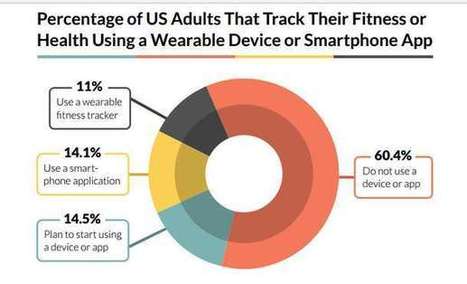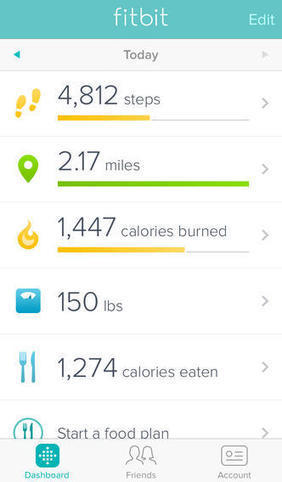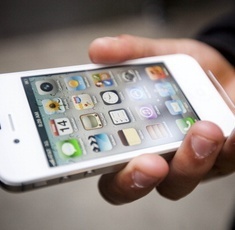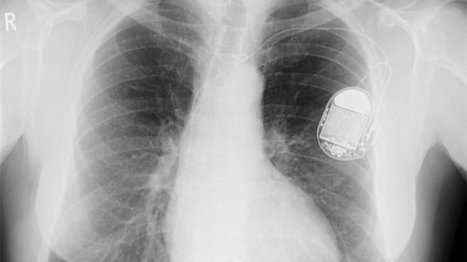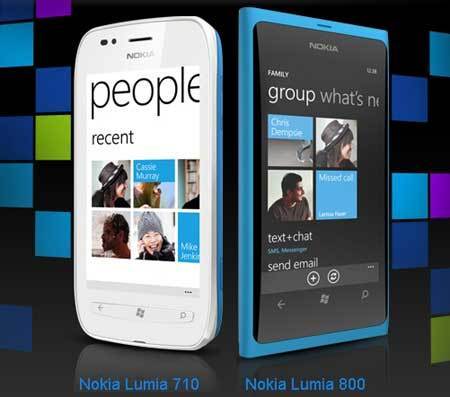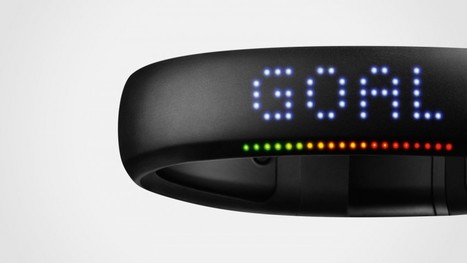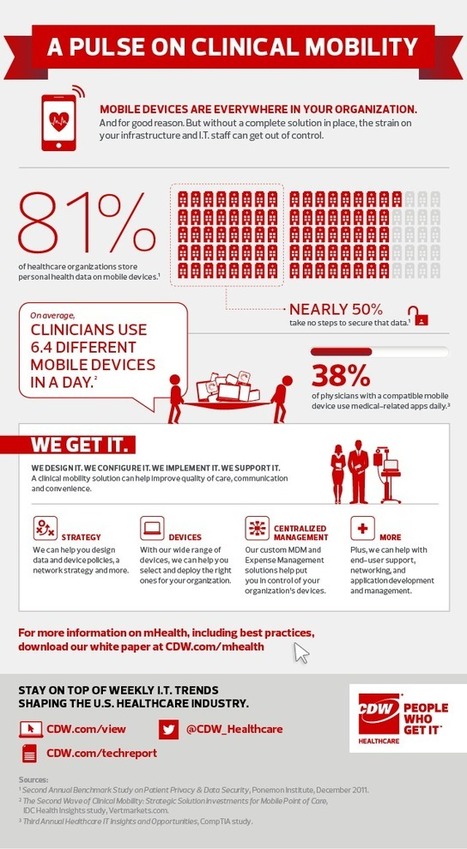 Your new post is loading...
 Your new post is loading...

|
Scooped by
nrip
|
Late last month, TechnologyAdvice released an interesting study looking at whether most people want to use health wearables such as fitness trackers and other tools for health purposes.
Here are the top-line results of this study:
- 75 percent of U.S. adults do not track their weight, diet, or exercise using a health tracking apps or devices
- 43.7 percent had no specific reason for not tracking their fitness
- 27.2 percent won’t use these devices due to lack of interest - 25.1 percent of adults are currently using either a fitness tracker or a smartphone app to monitor their health, weight, or exercise.
This sounds like pretty bad news for those who believe the era of health wearables is here. But, this study also raises another question: Are health wearables evangelists fools?
Fard Johnmar, Founder of Enspektos explains why relevancy is the key to boosting the adoption of health wearables.
Read more at http://hitconsultant.net/2014/10/08/are-health-wearables-evangelists-fools/

|
Scooped by
nrip
|
As the number of self-tracking health and fitness tools available to consumers continues to climb, a persistent question has been whether the data they collect might be useful to health researchers. Along with that: Are people who self-track comfortable sharing their data with researchers?
A new, must-read report from San Diego’s California Institute for Telecommunications and Information Technology (Calit2), funded by the Robert Wood Johnson Foundation, explores these and other questions.
Based on a survey with hundreds of self-trackers, a majority — 57 percent — said one critical assurance they would need before agreeing to make their self-tracked, personal health data available to researchers was that their privacy would be protected. More than 90 percent also said it was important that their data remained anonymous. Respondents said they’d be more comfortable sharing data if they knew it was only going to be used for “public good” research.
One open-ended survey that the report’s researchers posed to self-trackers found that 13 percent of respondents specifically mentioned an aversion to commercial or profit-making use of their data, according to the report. One respondent wrote: “It depends who gets it. Research using these data will be instrumental in the future of personal predictive services, but also for that reason are likely to be exploited by marketers and the politically short-sighted. Thus I would like transparency for who has access to my data.”
Among the almost 100 health researchers interviewed for the report, 46 percent said that they had already used self-tracking data in their research previously. Some 23 percent reported that they had already worked with digital health companies that offer apps or devices to consumers to track their health.
Overall, the researchers interviewed for the report were “generally enthusiastic” about the prospect of using self-tracking data in the future — 89 percent agreed or strongly agreed that such data would prove useful to their research efforts. Almost all of those researchers surveyed said that kind of data could answer questions that other data could not.
more at http://mobihealthnews.com/30979/health-researchers-see-unique-opportunity-in-self-tracker-data/
There are lots of medical apps available for smart phones and tablets, many of which are free or inexpensive. But how do you incorporate them into clinical practice?
The good news is you don’t have to invest in fancy equipment. If you’re asking about apps, you probably own a smart phone or tablet. Your patients who will benefit most from apps own the technology already, too. So the most efficient and effective way to start is to use the technology you have, and have learners use what they have.
Next step is to find the most appropriate resources. Do not start from “what apps are available?” That would not be patient-centered. Instead, ask: What conditions do my patients have? What do I teach about? What do my patients and their families need to learn? What questions do they have? What behaviors do they need help changing to optimize health?
There are 3 places apps might be used:
1. In the clinical encounter, as you explain something.
2. During a hospitalization, to engage the patient and family in the educational process.
3. At home, to provide information and support healthy behavior changes.
Read more: http://notimetoteach.com/2013/using-apps-to-enhance-patient-and-family-education/
Via Parag Vora

|
Scooped by
nrip
|
Google Helpouts is a new video service by Google that connects individuals seeking help with experts via real time online video. Healthcare providers are using the platform to connect with Patients. Helpouts is built on top of Google’s Hangouts platform and is HIPAA compliant.
Google says it was created to provide “real help from real people in real time.” People who offer help through the service are calledproviders and can be businesses as well as individuals. Providers must pass a screening process in order to qualify as Helpouts providers.
Once approved, providers create and maintain listings that explain their offerings, qualifications, prices and schedules. Payments are made through Google Wallet and pricing is based either per minute, per session, or free. While Google charges 20% of the fees, health-related providers are not yet being charged. Helpouts Providers can be rated at the end of a session by the user. more at http://www.imedicalapps.com/2013/11/google-helpouts-hipaa-video-physicians-patients/

|
Scooped by
nrip
|
Fraunhofer FIT has demonstrated a mobile wireless system that monitors the health of elderly people in their own homes with miniature sensors.
Such Ambient Assisted Living (AAL)systems continuously monitor the patients’ health in their homes and can help reduce the number of visits to the doctor. Miniaturised sensors integrated in mobile devices that are connected to medical centres can monitor and diagnose patients in their homes without reducing their quality of life.
In use, a nano potentiostat measures biochemical information in a patient’s assay, such as glucose, lactate or cholesterol levels.
A fluorescence sensor is used to detect colour-marked biomarkers whilst an SpO2 sensor monitors heart rate and arterial oxygen saturation.
A smartphone app then processes the data from the three sensors and transfers them to a server. For secure data communication, a Bluetooth connection with a specifically developed protocol is used.
As devices that measure biometrical data do not use standardised protocols, they developed a sensor platform that takes the data from the different sensors, processes them and sends them to a smartphone. The smartphone can then transmit the data to the patient’s physician.
|

|
Scooped by
nrip
|
Cardiologists in Los Angeles have developed a gene-therapy technique that allows them to transform working heart-muscle cells into cells that regulate a pigs’ heartbeat. This procedure, described today in the Science Translational Medicine, restored normal heart rates for two weeks in pigs that usually rely on mechanical pacemakers. The experiment, researchers say, could lead to lifesaving therapies for people who suffer infections following the implantation of a mechanical pacemaker.
"We have been able for the first time to create a biological pacemaker using minimally invasive methods and to show that the new pacemaker suffices to support the demands of daily life," Eduardo Marbán, a cardiologist at the Cedars-Sinai Heart Institute and lead author of the study, told the press yesterday. The approach is practical, added Eugenio Cingolani, a cardiogeneticist also at Cedars-Sinai and a co-author of the study, because "no open-heart surgery is required to inject this gene."
In the study, researchers injected a gene called Tbx18 into the pigs’ hearts. This gene, which is also found in humans, reprogrammed a small number of heart-muscle cells into cells that emit electrical impulses and drive the beating of the heart. The area in which this change occurred — about the size of a peppercorn — doesn't normally initiate heartbeats.
"We were able to get the biological pacemaker to turn on within 48 hours," Marbán said. To get the gene to the heart, the researchers sent a modified virus into the right ventricle through a catheter. The viral vector isn’t harmful, the researchers said, because the virus they employed was engineered to be "replication deficient" — meaning that it will not reproduce and spread beyond the heart.
Overall, the results of the study demonstrate that the pigs who received the gene therapy experienced an increase in heart rate that allowed them to be much less dependent on backup pacemakers. In contrast, the backup pacemakers were responsible for more than 40 percent of the beats in pigs who didn’t receive the gene therapy, but still underwent surgery.
more at http://www.theverge.com/2014/7/16/5906563/biological-pacemakers-gene-therapy-heart-muscle-cells

|
Scooped by
nrip
|
While much is made of the mHealth app market for consumers, a growing segment is being tailored for clinicians. Doctors are becoming as mobile as their patients, and they need the tools to access medical information as well.
Vendors are already moving in that direction, too. Take Orca Health, for instance, which has developed a platform of iOS 7 apps designed to help clinicians educate patients about certain conditions or medical procedures. The Patient Education for Healthcare Professionals platform, which currently features 10 apps, allows physicians to choose and edit medical content, capture photos and videos and securely send that information to the patient — in essence, enabling the physician to prescribe an app.
"Patient education is a monster, monster problem," said Matt Berry, Orca Health's founder and CEO, in an interview with mHealth News. Berry said the Orca Health apps (the company also has a line of iBooks through a partnership with Harvard Medical School) enable clinicians to personalize patient education, rather than relying on generic handouts. The physician sends the patient an e-mail with a link to a HIPAA-compliant web portal, where the patient can create a secure account and view that information. Subsequent prescriptions — videos, photos, links to information, histories of medical encounters and resolutions — can be added to the patient profile by the physician.
Apps currently available in the Apple App Store are Spine Decide, Knee Decide, Heart Decide, Eye Decide, Shoulder Decide, Foot Decide, Hand Decide, Dental Decide and Ear, Nose and Throat Decide (a Kids dental app is available for the Apple iPad).
Company officials said physicians using the Orca Health platform have improved patient retention rates by as much as 15 percent.
"Physicians are asking for these tools," Berry said. "They want to be able to prescribe that content for their patients."

|
Scooped by
nrip
|
The concepts of “self-tracking” and “the quantified self” have recently begun to emerge in discussions of how best to optimize one’s life. These concepts refer to the practice of gathering data about oneself on a regular basis and then recording and analyzing the data to produce statistics and other data (such as images) relating to one’s bodily functions and everyday habits. Some self-trackers collect data on only one or two dimensions of their lives, and only for a short time. Others may do so for hundreds of phenomena and for long periods.
The tracking and analysis of aspects of one’s self and one’s body are not new practices. People have been recording their habits and health-related metrics for centuries as part of attempts at self-reflection and self-improvement.
What is indisputably new is the term “the quantified self” and its associated movement, which includes a dedicated website with that title, and regular meetings and conferences, as well as the novel ways of self-tracking using digital technologies that have developed in recent years.
A growing range of digital devices with associated apps are now available for self-tracking [1]. Many of these devices can be worn on or close to the body to measure elements of the user’s everyday life and activities and produce data that can be recorded and monitored by the user. They include not only digital cameras, smartphones, tablet computers, watches, wireless weight scales, and blood pressure monitors, but also wearable bands or patches, clip-on devices and jewelry with embedded sensors able to measure bodily functions or movement and upload data wirelessly.
In many of these devices global positioning devices, gyroscopes, altimeters, and accelerometers provide spatial location and quantify movement. These technologies allow self-trackers to collect data on their moods, diet, dreams, social encounters, posture, sexual activity, blood chemistry, heart rate, body temperature, exercise patterns, brain function, alcohol, coffee and tobacco consumption, and many other variables.
Read more at the original source: http://ieeexplore.ieee.org/stamp/stamp.jsp?reload=true&tp=&arnumber=6679313

|
Scooped by
nrip
|
Personalized medicine is the tailoring of a medical treatment to the individual characteristics, needs and preferences of a patient. Many recent advances involve using a patient's genetic information to guide his or her treatment.
Developing a truly personalized approach to patient care will require fundamental advances in the understanding of the biological, anatomical and physiological mechanisms that underlie disease, and how they are affected by environmental, genetic, social and cultural factors.
To describe its unique responsibilities and its efforts in facilitating the advancement of personalized medicine, the Food and Drug Administration (FDA) has released a new report entitled "Paving the Way for Personalized Medicine: FDA's Role in a New Era of Medical Product Development
FDA's commitment to personalized medicine dovetails with its focus on advancing regulatory science, which is the science of developing new tools, standards and approaches to assess the safety, effectiveness, quality and performance of FDA-regulated products.
Here are some examples from the report of how FDA is using regulatory science to help speed the development of promising new personalized medicine therapies.
Virtual patient: Advances in medical imaging and the power of computers to create virtual, anatomically correct models of the human body have enabled the use of patient-specific computer simulations in clinical practice and medical device development. This has facilitated the creation of personalized, custom-built medical devices. FDA's Center for Devices and Radiological Health (CDRH) is developing a publicly available digital library of such models and simulations. This space for collaboration and sharing will help advance the personalization of medical device development and use.
Clinical Trial Designs and Methods: FDA is working to refine clinical trial design and statistical methods of analysis to address issues that often arise in the development of targeted therapeutics. The agency is also looking specifically at clinical trials for the development of cancer drugs. For example, FDA is participating in the "I-SPY 2 Trial," a groundbreaking clinical trial model that will help scientists quickly test the most promising drugs in development for women with rapidly growing breast cancers.
Biology of cancer: FDA's National Center for Toxicological Research (NCTR) conducts research to improve the understanding of cancer's underlying biology. A research project focused on the KRAS oncogene, for example, established that many tumors carry subpopulations of KRAS mutant cells, which can contribute to an acquired resistance to some cancer treatments.
Identification of genetic risk factors for vaccine reactions: FDA's Center for Biologics Evaluation and Research is involved in research collaborations that focus on identifying genetic risk factors associated with negative reactions to vaccines.
Genetics and cardiovascular risk: In collaboration with researchers at the University of Maryland, scientists at NCTR are conducting research to identify genetic factors that interact with common lifestyle factors—such as diet and drug exposure—to contribute to cardiovascular disease.
Personalized medicine for heart devices: Researchers at CDRH have made major advances in understanding the underlying biology of heart disease. They have used new methods to analyze electrocardiograms to identify the causes of heart disease and to predict which patients will benefit from specific cardiovascular treatments. These new methods are being used by outside research groups and may be used to design more efficient clinical trials in the future.

|
Scooped by
nrip
|
Mobile devices are everywhere in your healthcare organization, but without a complete solution in place, the strain on your IT staff can get out of control. Mobile devices among healthcare professionals has exploded over the last few years. On average, clinicians use 6.4 different mobile devices in a day on average according to IDC Healthcare Insights Study. Mobile health devices provide healthcare professionals with the ability to facilitate smoother workflows and help boost productivity.
|



 Your new post is loading...
Your new post is loading...

